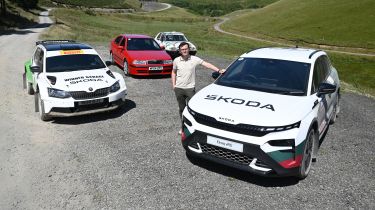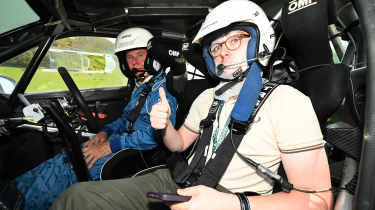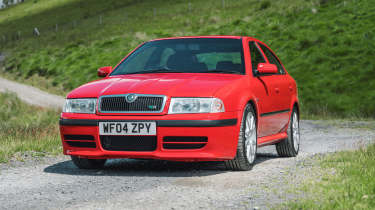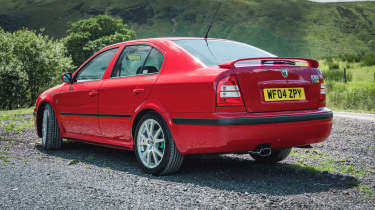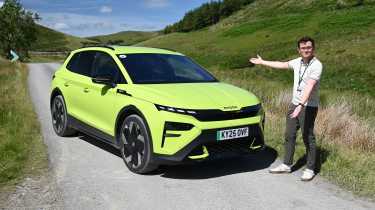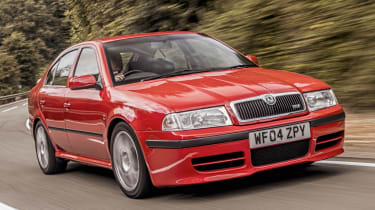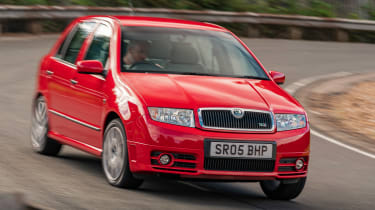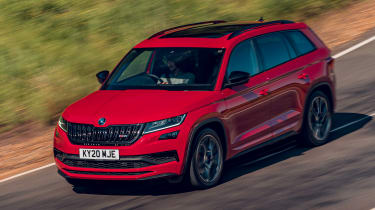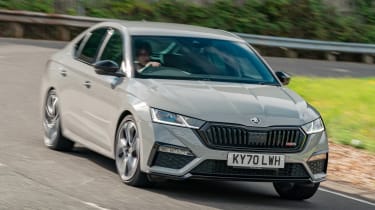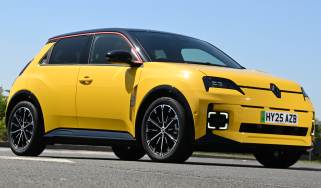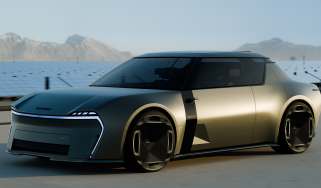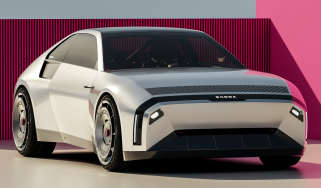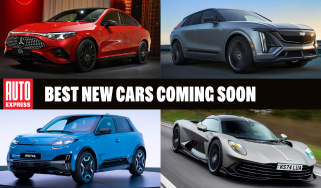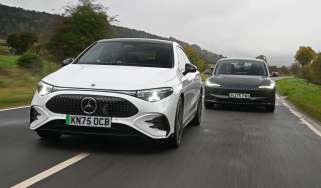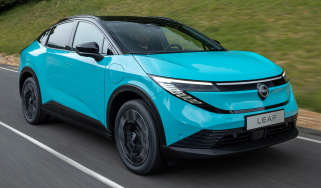What is Skoda vRS? Past, present and future of Czech performance powerhouse
This rally-inspired name recasts everyday models as hardcore variants – and transformed Skoda’s image
Compromise is often the name of the game when it comes to performance cars; you usually have to give up something – whether that be comfort, practicality or, most commonly, price – if you wish to transform an everyday motor into a hardcore driving machine.
This isn’t the case with Skoda vRS models, however, because thanks to the Czech manufacturer’s focus on value and everyday performance, this speedy sub-brand has struck a chord with British buyers in particular.
Once little more than the butt of a bad joke, Skoda now outsells the likes of Renault, MG and even Tesla in the UK, and one in 10 new examples is registered wearing the vRS badge.
So to find out what vRS is doing right for the Skoda brand, we headed deep into Welsh rallying territory to get behind the wheel of some iconic models from across the sub-brand’s history, and speak to one of the key figures behind it all: Bjorn Kroll, Skoda’s head of product marketing.
What does vRS mean?
First and foremost, it’s worth acknowledging the history of vRS and what those three letters actually mean. Officially, vRS stands for ‘Victory Rally Sport’, although such an abbreviation was primarily chosen because Ford believed that it held the copyright to the ‘RS’ moniker in the UK – despite the American giant choosing to spell ‘Rallye’ with an ‘e’ suffix.
Nevertheless, to avoid any courtroom drama, Skoda instead opted to add a small ‘v’ at the front. This was also a nod to the caron typically positioned above the ‘S’ in ‘Škoda’, although in this instance it denoted ‘victory’. However, just to confuse things further, hot Skodas sold outside the UK still get the ‘RS’ designation, despite sharing the same logo derived from a racing livery worn by the successful Skoda Favorit rally car.
Skoda’s motorsport heritage
Speaking with Auto Express, Kroll says: “The vRS badge is one of the most important pillars of Skoda’s brand identity, because it ties together heritage, performance and emotion.”
While Skoda might not be a brand one immediately associates with motorsport, its history with racing goes all the way back to 1901, when a Laurin & Klement (Skoda’s predecessor) motorcycle was entered into a long-distance race from Paris to Berlin. The type of motorsport the company truly made its mark in, however, was rallying. Over the decades, Skoda achieved podium places across multiple classes with cars such as the Popular Sport, Felicia and Favorit – the last of which even clinched the FIA 2-Litre World Rally Cup in 1994.
Skoda’s rallying success continues today with the Fabia R5 and its successor, the Fabia R5 Rally2. To give us a taste of what a true Skoda rally car can do, the firm organised a ride in an R5 at the Sweet Lamb Motorsport Complex
The most successful Rally2 car of all time, the Fabia R5 offers similar weight and power to that of the full-fat Octavia WRC. If you’ve never ridden shotgun in a rally car before, nothing can prepare you for the sheer brutality of it; the boom of the Fabia’s 1.6-litre petrol engine was just as relentless as the manner in which it scrambled up the twists and turns of Sweet Lamb.
The harsh gearshifts of the R5’s sequential manual transmission make the automatics of modern road-going vRS models feel buttery smooth, while a big jump at the end of the Sweet Lamb run felt akin to the renowned ‘Fafe jump’ of the Portuguese Rally, where the updated Rally2 Evo made its debut in 2019 and subsequently took victory.
What was the first Skoda vRS model?
The Fabia R5 is based on the Fabia vRS road car. However, the Fabia was not the first Skoda to get the RS designation – nor was the Octavia vRS that many assume was.
Back in the seventies, Skoda developed the 200 RS rally prototype in order to compete in higher competition classes. Boasting a 161bhp 2.0-litre engine linked to a five-speed Porsche-derived manual gearbox, plus a lightweight bespoke aluminium body, the 200 RS was poised to fare well against the competition, which at the time included the legendary Lancia Stratos and Alpine A110.
Along with the smaller-displacement 180 RS, the Skoda prototype saw only a handful of races before the sport’s governing body, the Fédération Internationale de l’Automobile (FIA), banned non-series-production prototypes. The following year, however, saw the arrival of the 130 RS, which took victory not only at the 1977 Monte Carlo Rally, but at the 1981 European Touring Car Championship title as well.
It wasn’t until 2001 that the vRS brand as we know it today was launched with the true icon that was the Skoda Octavia vRS. One of the first cars to be developed following Volkswagen Group’s acquisition of the Skoda brand in 1991, the Octavia and the subsequent vRS variant were landmark models for the Czech automotive manufacturer, with the latter being produced to commemorate Skoda’s growing confidence within the World Rally Championship (WRC).
Incorporating high-quality items from the Volkswagen parts bin, the first-generation Octavia – as with the fourth-generation car on sale today – was based on the contemporary Golf. Also similar to now, the original vRS also shared the Golf GTI’s 1.8-litre four-cylinder engine, which produced a healthy 178bhp.
The first Octavia vRS doesn’t feel particularly fast when driven today – its modern vRS equivalent boasts roughly 80 horsepower more. There is quite a bit of turbo lag in the original, but pass 3,000rpm and there is noticeably more shove, with peak power being delivered at 5,500rpm. It’s not an engine that particularly revels in being revved, though, nor does the exhaust note provide much zing or zest.
What the Octavia does feel, though, is palette cleansing; the vRS is nowhere near as knuckle wrenching as some hot hatches of its era, yet its relatively light steering offers plenty of progression, which gives you the confidence to hurl the car into a corner with gusto and make use of the surprising amount of grip on offer.
The most defining part of the Octavia vRS recipe, however, is the ability to throw the soft-yet-satisfying gearstick into a higher ratio and cruise along in comfort and even something close to efficiency. We found the ride and seats to be more than comfortable enough for everyday use, while the Octavia’s relatively compact dimensions make it easy to drive on both fast country and busy urban roads.
All of this made the original Octavia vRS a great option for those looking for something with sporting prowess, but which also wasn’t spine-shattering to live with every day. As a result, Skoda sold a respectable 1,457 units in the UK throughout the car’s five-year production run.
“The success of the Octavia vRS has given Skoda its own ‘halo car’,” Kroll explains. “It’s iconic in Europe, and is often the entry point into the brand for enthusiasts.”
Skoda’s sweet spot
Following the arrival of the Mk1 Octavia vRS, Skoda immediately knew it had found a formula that worked – one that struck a more desirable balance between offering high performance without the extreme compromises that rivals with deep associations with performance often had.
“We believe the balance of sportiness and usability makes vRS unique compared with purely performance driven brands,” Kroll says.
Skoda’s second vRS model perhaps embodied this philosophy to an even greater degree; the first-generation Fabia vRS curiously utilised a Golf-derived 128bhp 1.9-litre diesel powertrain. This didn’t quite have the same level of rortiness as its petrol-powered successor – blindfold someone and they’d be forgiven for thinking
the sound was coming from a van. However, it delivered strong power in the low and mid-range, making the hot Fabia feel a lot more muscular than the numbers might have suggested.
Of course, choosing this particular diesel powertrain means there’s quite a bit of extra weight over the front axle. However, the limits to which you can push the car through a corner until it begins to understeer are further than you might expect, eliciting a big grin as we wove the car through the narrow and winding upland roads surrounding Sweet Lamb.
Yet despite its get-up-and-go nature, the Fabia vRS is very much unlike a typical performance car in the sense that it was cheap to buy and run when new – it claimed an official 55mpg. While it does lack the visual bling of rivals, not everyone wants an ‘out-there’ hot hatch, with many buyers instead favouring the understated purposefulness of vRS cars.
Even today, with Skoda’s striking new Modern Solid design philosophy, vRS models don’t stray all that far in terms of design from their standard counterparts except, perhaps, some black trim, larger alloys and, in some cases, bright green stitching on the inside.
“Modern Solid provides Skoda with a distinctive, functional and emotionally engaging design language that strengthens our brand identity,” Kroll tells us. “That said, the design differentiation between vRS and non-vRS models remains consistent. We continue to follow the same proven formula, ensuring that vRS stands out through performance and character rather than a separate design direction.”
Skoda vRS goes electric
Speaking of Skoda in the present day, it’s hard not to mention the vRS brand’s transition into the electric era. Admittedly this has been a difficult time for all automotive firms, as they grapple with both the benefits and the drawbacks inherent in the fundamental make-up of EVs.
“Every maker faces the same challenge: moving from light, agile hot hatches such as the original Fabia vRS TDI to heavier, two-tonne EVs such as the Enyaq vRS,” Kroll explains. “Fortunately, tech advancements help offset this added weight. Take adaptive dampers (DCC), for example: they keep the car composed and responsive during spirited driving, yet deliver impressive comfort for daily journeys. It truly is the best of both worlds.”
This is certainly the case for the newest Elroq vRS, the high-performance version of the current Auto Express Car of the Year. Even on the largest 21-inch wheels, the adaptive dampers ensure that the model is comfortable on long journeys, but switch the Elroq vRS into its sportiest setting and body roll is largely kept in check.
However, while vRS models have never been the most exhilarating options on the market, both the Enyaq and Elroq vRS models, despite their undeniable performance, could be accused of feeling somewhat sterile – primarily due to the lack of noise and feedback. Case in point: even with a rally-inspired wrap, the Elroq vRS couldn’t disguise its light steering and lack of sensory stimulation when we drove it.
Skoda has taken both customer and journalists’ opinions on board, though, and has previously hinted that its next batch of hot EVs might feature elements such as augmented engine sounds and more aggressive tuning to inject some much-needed fun into the overall package.
Kroll says Skoda is “ensuring that any added sound or vibration [implemented] feels authentic and not artificial. Rather than simply imitating ICE engine noises, we create a unique character that enhances the driving experience in a natural way”. When asked whether the brand is also developing a system to emulate the gearshifts of an auto car, Kroll says: “This is something we’re exploring.”
If you’re not enraptured by Skoda’s electric offering, worry not – because the manufacturer has already hinted that the next-generation Octavia vRS could retain a petrol engine in the form of a plug-in hybrid powertrain.
“The [now-discontinued] Octavia iV vRS marked a milestone as the first electrified vRS model, proving that driving excitement and eco-consciousness can go hand in hand,” Kroll continues. “So why wouldn’t that formula continue to work in the future?”
Perhaps, then, it’s a plug-in hybrid set-up that best represents the admired duality of the vRS brand: comfortable and quiet most of the time, but sensory and powerful when you need it.
It will be a while before we see a fresh hybrid-powered vRS, with the next-generation hot Octavia set to be launched in 2027. Before that will be the arrival of the new electric Skoda Epiq small SUV, which will undoubtedly also be available in vRS guise.
As Kroll previously reassured us, however: “What you see on electric cars today, on vRS, is just the beginning. We will, for sure, try to push even more – going in the direction of what we are used to from the ICE cars.”
Skoda vRS: the cars
Skoda's vRS range is quite a broad one, so, naturally, we tried out some of the very best cars from the past and present.
Skoda Octavia vRS Mk1
We begin with the original: the Mk1 Octavia vRS. Few people expected the arrival of a high-performance, motorsport-inspired Skoda in 2001, yet this was the brief for the brand’s first modern performance model.
Today, the Octavia vRS looks familiar – mundane, even – but with a purposeful edge unlike any of its forebears, which describes the driving experience to a tee. The cabin gives little indication of the car’s sporting pretence, aside from supportive front seats and a vRS gear knob. Otherwise it’s a masterclass in turn-of-the-century black and grey sobriety. That’s not necessarily a bad thing; there are no bright screens glaring back at you, and large buttons remain far easier to use than a touchscreen. Here, fewer features mean it’s easier to focus on the driving experience.
Wiggle the gearlever, note its springy action across the gate, and fire up the motor. It’s the same 180bhp, 1.8-litre turbocharged unit from the Mk4 VW Golf GTI, and it sounds particularly subdued here. The steering demands more effort than expected, but it exudes more tactility than you might think. It’s a pleasant blend of fun and usability, with a supple ride, decent refinement, communicative controls and compact dimensions. It’s an appealing package today, so no wonder it proved popular as a new car.
At the time, this was the fastest production Skoda ever, and happily, when you push harder, it still delivers. The engine is flexible with a strong mid-range providing a decent turn of speed. It’s not vocal, and there’s little use in chasing the 6,500rpm red line, but its undramatic delivery pairs well with the Octavia’s measured attitude.
The chassis shines brighter still. The steering lacks ultimate feedback, but there’s still plenty of it, and it’s fun, something the sub-1,400kg kerbweight contributes to.
Skoda Fabia vRS Mk1
The shift in character between the Octavia vRS and the original Fabia vRS, which landed two years later, is striking. Powered by a 1.9-litre diesel motor producing 130bhp, the VW Polo-based hot hatch typified an industry-wide move towards diesel during the early noughties, and aimed to carry the Octavia vRS’s ethos in a smaller, frugal package.
As with its larger, petrol-driven relative, the Fabia vRS looks humble, and certainly not one you’d expect to produce more torque than a contemporary Porsche Boxster. Drive it, however, and there’s no doubting the figures.
Whereas the Octavia required a few revs to tap into that mid-range, the Fabia can comfortably sit a gear higher, pulling strongly from down low with a healthy swell of torque. Instead of straining the engine, you sit back, hover over the throttle and make swift, effortless progress, while keeping that noise at a distance. Then you can concentrate on the feelsome steering, compliant chassis and the heightened agility afforded by a shorter wheelbase than the Octavia. The turn-in is blunted by the heavy diesel engine, but the Fabia is enjoyable to thread along, with controls that share the tactility of the Octavia’s.
It’s perhaps here, more than anywhere else, where the advances in technology are clearly felt. The 1.9-litre TDI sounds and feels agricultural by today’s standards, and the exhaust smell confirms just how clean modern diesels are.
There was logic in producing a diesel hot hatch back then; the promise of more than 50mpg and reduced CO2 meant it was cheap to run. But as a performance model, it was compromised. The chassis delivered a spritely drive, but the engine’s torque delivery meant there was little pleasure in wringing it out, as you might in any other landmark hot hatch. As a result, the Mk1 Fabia vRS is a pleasant road car, but stops short of being a memorable one.
Skoda Kodiaq vRS
How much vRS DNA can you inject into a seven-seat, diesel SUV? A fair bit, as it happens. The Kodiaq vRS taps into today’s trend of sporting SUVs, and while a 4x4 is an unlikely candidate for the vRS treatment, it’s effective: it’s the fastest seven-seater to lap the Nürburgring.
You’d be hard pressed to notice any vRS traits at normal speeds – a vRS hallmark. You sit high, and although this is a large SUV, the linear, accurate steering allows it to shrink around you more than expected. The ride is the plushest of all the models tested here, and the DSG gearbox is slick, limiting the noise from the 2.0-litre diesel engine.
The Kodiaq emits a synthetic warble through the speakers to mask the diesel clatter. Its 1,880kg is respectable for a seven-seat SUV, and the linear, pure combustion power is refreshing after the inconsistent response of the Octavia PHEV. Batting the paddles keeps the car in its sweet spot, at which point the Kodiaq moves at a decent, if not rapid, pace.
The real surprise is in the corners. It’s not super-sharp, but it remains composed and capable. The high-set chassis doesn’t communicate quite as well as the Octavia vRS iV’s, but the increased centre of gravity provides an extra layer to the dynamics. Where the Octavia will carve through difficult roads unflustered, the Kodiaq allows the driver to pitch the car in and use weight transfer to manipulate the balance. They’re subtle movements that don’t require correction, but they serve as a reminder that the car is near the edge. Unsurprisingly, the big Kodiaq is at its weakest on the brakes, but overall, this is a more gratifying car than the hybrid Octavia vRS on a challenging road – shock horror.
Skoda Octavia vRS iV PHEV
The lineage of accessible, usable performance cars under the vRS moniker has continued to the current age of electrification. The Octavia vRS iV is a plug-in hybrid performance hatch that borrows its chassis and running gear from the Mk8 Volkswagen Golf GTE, and looks to tie up pace, efficiency and fun in a single, practical package.
Having just climbed out of its near two-decade-old brethren, the iV feels opulent and well isolated, but with that brings a remoteness to its responses. The steering, although far more accurate and incisive, doesn’t load up with the same organic feel, and the brake regeneration system gives a springy feel to the brake pedal. In EV mode, the Octavia is eerily quiet and free of drama, which isn’t something from the established hot-hatch playbook.
Even when you’re up to speed, the Octavia vRS iV doesn’t quite hit the spot. Calling upon the 1.4-litre turbocharged petrol engine brings a sudden intrusion of noise, but not the kick of forward propulsion that you’d expect. Its 242bhp is a strong figure on paper, but the iV brings a near-200kg weight penalty over the standard vRS. The torque-fill of the electric motor masks turbo lag well, but it’s disappointing that the vRS iV never feels like an outright performance car.
Once you adjust to the synthetic controls, the Octavia vRS iV’s pure cornering ability impresses. The leap in chassis technology from the early noughties is evident; the Octavia is unflustered over mid-corner bumps that send shudders through the older cars, and the grip reserves are far higher. And where the Mk1 Octavia rewards spirited driving with a hint of slip from either axle, the vRS iV obeys the same commands in a neat, effective fashion. Pushing harder than that, on the road at least, feels inappropriate. Instead, you settle into a groove with the hybrid vRS, aiming it with accuracy between the white lines at a brisk pace. The Octavia vRS iV is an accomplished car, but we wish it was a little less Skoda, and a bit more vRS.
Perhaps the current Octavia vRS is closest to the original Fabia vRS in that regard, then. It’s a hot hatchback designed for the world around it. Diesel was king in the early noughties; today it’s electrification that rules the roost.
Our dealer network has 1,000s of great value new cars in stock and available now right across the UK. Find your new car…
Latest Skoda deals
Find a car with the experts

